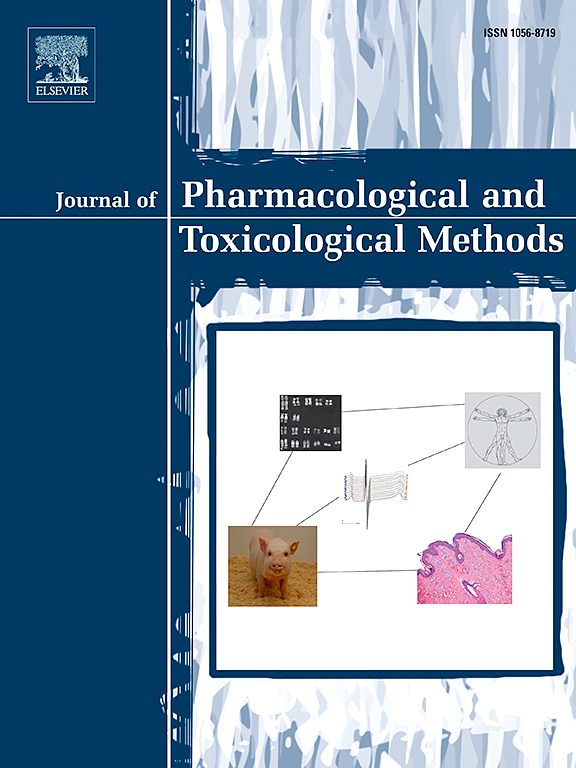Telemetry in toxicology studies – A comparison of data across species, technologies and time
IF 1.3
4区 医学
Q4 PHARMACOLOGY & PHARMACY
Journal of pharmacological and toxicological methods
Pub Date : 2025-05-20
DOI:10.1016/j.vascn.2025.107757
引用次数: 0
Abstract
Telemetry technology allows collection of quantitative cardiovascular safety pharmacology data in repeat dose toxicology studies. The ICH M3(R2) guideline suggests that inclusion of safety pharmacology endpoints into toxicology studies should be considered wherever feasible, and where similar rigor can be achieved, to reduce animal use. The objective of the current analyses was a comparison of the cardiovascular data collected using telemetry technology in stand-alone and toxicology studies.
Pretreatment and vehicle control data were gathered from 75 studies for 780 dogs and 1059 nonhuman primates (NHP), and over 4503 days. Three technologies were used: a dual pressure implant used in stand-alone studies, a smaller single pressure implant and jacketed external telemetry. The latter was coupled with a minimally invasive blood pressure implant in a few studies.
Mean QTc values were practically identical between L21, M11 and JET® telemetry data in NHP (differences of 1–3 ms). In dog, M11 and JET® telemetry had mean QTc values which were different by 2 ms. These were 5–7 ms shorter than for L21 telemetry. All the confidence intervals for the different technologies had substantial overlap (68–91 % overlap for dog and 92–97 % overlap for NHP). The QTc data were also stable over time. The predicted change from baseline QTc for a 100-day span between assessments was 0.07 ± 0.15 ms for dog and 1.22 ± 0.19 ms for NHP. The mean arterial blood pressure (MAP) was also similar across all technologies and stable over time (0.56 and − 2.18 mmHg for 100-day span in dog and NHP).
These analyses demonstrate that the technology used in toxicology studies provides similar data to that in stand-alone studies and the data is stable over long periods. Longitudinal assessment is important for new modalities where pharmacodynamic effects can be delayed, and in assessment of potential chronic blood pressure changes.
毒理学研究中的遥测。跨物种、技术和时间的数据比较
遥测技术允许在重复剂量毒理学研究中收集定量心血管安全药理学数据。ICH M3(R2)指南建议,在可行的情况下,应考虑将安全药理学终点纳入毒理学研究,并在可以实现类似严格性的情况下,以减少动物使用。当前分析的目的是比较在独立和毒理学研究中使用遥测技术收集的心血管数据。在4503天的时间里,对780只狗和1059只非人灵长类动物(NHP)进行了75项研究,收集了预处理和对照数据。使用了三种技术:用于独立研究的双压力植入物,较小的单压力植入物和夹套外部遥测。在一些研究中,后者与微创血压植入物相结合。NHP中L21、M11和JET®遥测数据的平均QTc值几乎相同(差异为1-3 ms)。在犬类中,M11和JET®遥测的平均QTc值相差2 ms。这些时间比L21遥测短5-7毫秒。不同技术的所有置信区间都有很大的重叠(狗的68 - 91%重叠,NHP的92 - 97%重叠)。随着时间的推移,QTc数据也很稳定。与基线QTc相比,在100天的评估期间,狗的预测变化为0.07±0.15 ms, NHP的预测变化为1.22±0.19 ms。在所有技术中,平均动脉血压(MAP)也相似,并且随着时间的推移而稳定(狗和NHP的100天内分别为0.56和- 2.18 mmHg)。这些分析表明,毒理学研究中使用的技术提供了与独立研究相似的数据,并且这些数据在长期内是稳定的。纵向评估对于药效学效应可能延迟的新模式和评估潜在的慢性血压变化很重要。
本文章由计算机程序翻译,如有差异,请以英文原文为准。
求助全文
约1分钟内获得全文
求助全文
来源期刊

Journal of pharmacological and toxicological methods
PHARMACOLOGY & PHARMACY-TOXICOLOGY
CiteScore
3.60
自引率
10.50%
发文量
56
审稿时长
26 days
期刊介绍:
Journal of Pharmacological and Toxicological Methods publishes original articles on current methods of investigation used in pharmacology and toxicology. Pharmacology and toxicology are defined in the broadest sense, referring to actions of drugs and chemicals on all living systems. With its international editorial board and noted contributors, Journal of Pharmacological and Toxicological Methods is the leading journal devoted exclusively to experimental procedures used by pharmacologists and toxicologists.
 求助内容:
求助内容: 应助结果提醒方式:
应助结果提醒方式:


